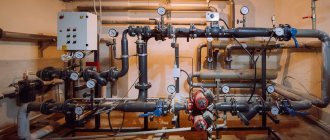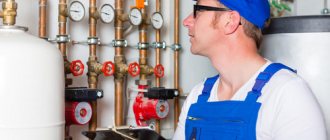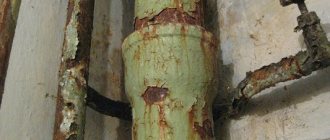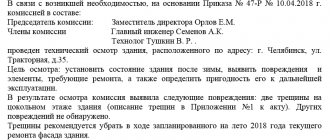Water metering unit of a residential building after major repairs
The topic of our article today is the repair of cold and hot water supply systems. We have to find out what the difference is between emergency, current and major repairs, how long it takes to completely replace the building’s water supply system, what materials are used to carry it out, and how individual faults in the engineering systems of a residential building are eliminated. For the convenience of the reader, we will structure the article in the form of answers to frequently asked questions.
Definitions
- What are the differences between the types of repair of engineering systems?
- Emergency repairs are a set of urgent measures designed to eliminate flooding of residential and common premises, as well as restore water supply to the consumer;
- Routine repair of the water supply system includes measures to eliminate faults that are not related to the cessation of utility services or emergency flooding. For example, eliminating a break in a cold water supply riser is considered an emergency repair, and replacing its section in order to restore the dropped water pressure is considered an ongoing one;
Current repairs: cold water supply through the riser has been restored using a polypropylene pipe
- Planned preventive maintenance of water supply is aimed at restoring or maintaining the functional properties of equipment, structural elements or components. This includes, for example, periodic welding of valve wedges and restoration of the diameter of retaining washers worn out by erosion in the elevator unit;
- Finally, overhaul is aimed at completely restoring the operational properties of the engineering system or its individual components. Examples are complete replacement of cold water and hot water systems, replacement of a bottling or water meter unit.
Overhaul of the water supply system: fillers and risers replaced
Please note: there are no clear boundaries between types of repairs. For example, it is difficult to distinguish current water supply repairs from major repairs in the case of a complete replacement of a worn-out water supply riser. The same applies to emergency and routine repairs: welding a fistula on an eyeliner or heated towel rail can be classified in one category or another depending on the size of the defect.
Current repairs of cold water supply: replacement of the bottling area
Types of water supply system repairs
Repair of the water supply system can be major or local in scale. Conclusions about a breakdown or other malfunction can be made when a specially trained person (master) carries out a comprehensive diagnosis of the pipeline. The repair work itself is divided into the following types:
replacement of all heating devices (this can be classified as a major overhaul);
installation of new boilers and boilers (partially related to major repairs, but the local nature of the work is more pronounced);
changing the water supply scheme and re-laying the pipeline (equally applies to local and major repairs, depending on the scale of the work).
Figure 2: Plumber
Periodicity
- How long does it take for a water supply system to need major repairs?
The vast majority of buildings in use were built during the USSR or in the early post-Soviet years and were equipped with steel water pipelines.
Departmental construction standards VSN 58-88 establish for them the following periods between repairs:
- Galvanized cold water pipes - 30 years;
- Black cold water pipes - 15 years;
- Galvanized hot water pipes with a closed heat supply system - 20 years;
- Black hot water pipes with a closed heating supply system - 10 years;
- Galvanized hot water pipes with an open heating supply system - 30 years;
- DHW pipes are black with an open heating supply scheme - 15 years.
The document establishes the service life of building structures and engineering equipment
When setting the timing of repair work, the actual state of the water supply is taken into account: major repairs, for example, are still not required for many Stalinka buildings with galvanized water pipes assembled on threaded connections.
Galvanized pipes are mounted on threads. Welding burns the zinc coating and the seam begins to rust
Basics of water supply system overhaul
Efforts directly related to major repairs (such as installation of equipment and careful preparation of the work site) entail the need to purchase materials that should not be expensive and at the same time need to be suitable for the consumer in terms of their quality characteristics. Stainless steel, brass or plastic are choices worth considering. After choosing the material, you need to take care of the parts (couplings and fastenings to them) and tools that may be needed for repairs.
Advice! And so that for you personally the installation and repair of the water supply system does not take too long or even end badly, you should entrust this matter to professionals.
Figure 3: Preparing the water supply system for repair
Payment
- At whose expense are repairs carried out?
Emergency repairs of hot water supply and cold water supply are usually performed free of charge for residents. If a water leak occurs through their fault (due to errors in self-installation of the water supply system, etc.), the emergency service turns off the problem area of the water supply system (pipeline or riser), transferring the request to the maintenance service.
Further. Different sections of the water supply system may belong to the property of the apartment owner or to the common property of the residents of the house.
The boundary passes through the connection of the tap on the supply line to the branch from the riser: everything before this connection is common property, the tap itself and the connections after it are individual property. If the general water supply is faulty, current repairs are carried out at the expense of the management company, if individual, the elimination of the fault is paid by the owner.
Repair of a bathroom with water supply is carried out at the expense of the homeowner
Scheduled preventive maintenance affects only the common property of residents and is carried out at the expense of the management company (more precisely, the costs for it are covered by utility bills).
Finally, the cost of major repairs is included in the rent as a separate item. It is carried out as the required amount accumulates in municipal accounts.
Payment for major repairs of a building
Please note: by decision of the residents' council, major repairs may be carried out ahead of schedule. In this case, the lack of funding is covered by the residents from their own funds, after which they are for some time exempt from paying contributions for repair work.
Water supply system repair
The repair of water supply systems, its types (local and major), features and rules of implementation are considered from “a” to “z”. The most common malfunctions of the water supply system are described and recommendations for eliminating them are given.
For a comfortable life, a modern person needs all the benefits of civilization: electricity, hot water, sewerage, and so on. But, unfortunately, all systems tend to fail. The water supply system was no exception. High-quality repair of water supply systems is something that can really make life much easier for everyone, because sudden disruptions and constant breakdowns will not add optimism to anyone, but on the contrary, they will create a heap of problems, a lot of troubles and a lot of inconvenience. However, the reasons for these massive disturbances are always different and are not always subject to any calculations. These may include long-term operation of the water supply system or improper use of outdated plumbing equipment, as well as uncontrollable pressure differences in various sections of pipes of complex design. (See also: Water supply risers)
Figure 1: Installation of water supply system
Problems and solutions
- Is it possible to carry out minor repairs to the water supply in an apartment yourself?
In general, repair work must be carried out by the organization servicing the building or by a third party after concluding a contract with it. However, an apartment owner with minimal experience in plumbing work can easily fix a number of minor faults with his own hands. Let's look at a few typical repair scenarios.
Fistula on the eyeliner or riser
Symptoms: water leaking on a smooth section of a steel water supply pipe.
Fistula on the connecting sleeve of the cold water riser
Reason: through corrosion of the pipe (most often along a welded joint or longitudinal seam).
Reference: all water and gas pipes produced in accordance with GOST 3262-75 are electric welded. They are made by rolling up a strip (flat tape) and welding the longitudinal seam.
Remedy: installation of a repair clamp. It can be replaced with a rubber gasket for the faucet, pressed against the defective section of the pipe, cleaned of rust and paint, with an aluminum clamp or binding wire.
Repair clamp for water supply pipes with a hex key for its installation
Installation of a bandage made of an aluminum clamp and a rubber gasket
Leak along the drain
Symptoms: water drips from the lock nut or long thread on the drain after the valve (at the entrance to the apartment, hard supply to the sink mixer or drain tank).
Causes:
- Rotting or burning out of the organic fiber of the winding;
- Mechanical impact on the threaded connection;
- Through corrosion of the thread of the drive. At the thread cavities, the pipe wall has a minimum thickness.
Leaking corroded pipe
Remedy:
- Rotten or burnt out winding is replaced with a new one. To do this, when the valve at the water supply inlet to the apartment is closed, it is necessary to unscrew the lock nut 3-4 turns, remove the remnants of the old winding, wind several turns of a new one and tighten the lock nut with moderate force;
Hint: as a winding, you can use polyester thread with silicone (for example, Tangit Unilok) or sanitary linen impregnated with silicone or quick-drying paint. It is not advisable to use FUM tape: a connection wound with it will leak with minimal reverse movement of the locknut.
Sealing thread for thread
- If the connection is loosened by mechanical force, it is enough to tighten the locknut with moderate force;
- The corroded lead is replaced with a new (preferably brass) lead of the same length. To replace it, you need to turn off the water, fit the locknut and coupling along the long thread, unscrew the drive from the valve and reassemble the connection in the reverse order.
Assembling the connection with the drive. 1 — drive, 2 — supply after the valve, 3 — coupling, 4 — lock nut
Weak water pressure at one tap point
Symptoms: low pressure of cold or hot water on one of the faucets.
Reason: clogging of the faucet seat or liner in front of the mixer.
Remedy: turn off the water, unscrew the faucet and clean the seat and the connection in front of it through the hole in the mixer body with a thin cable.
Access to the blockage in the line in front of the mixer can be obtained by unscrewing the faucet
Low water pressure throughout the apartment
Symptoms: low pressure of hot water or hot water at all water points.
Reasons: clogged coarse filter at the entrance to the apartment; blockage or accumulation of deposits in the water supply line before or after the valve.
Filters are located at the water inlet into the apartment and serve to protect meters and plumbing from sand and rust.
Remedy: cleaning the filter after turning off the water using the valve on the inlet or cleaning the inlet itself. In the latter case, you need to shut off the water along the riser. The cable is inserted into the connection through an opened screw valve, and in the case of a ball valve, through an unscrewed connection or an opened filter.
In the photo - deposits in the cold water line in front of the valve
Valve stem leaking
Symptoms: Water flows down the screw valve stem.
Leak location
Cause: worn out O-ring or seal.
Remedy: Open the valve all the way. In this case, the thread of the rod should press the oil seal from below, which will stop the leak. If this does not help, refill the oil seal.
Here is the order of work:
- Close the valve;
- Remove the lamb;
- Unscrew the nut on the rod;
- Use a screwdriver or pliers to remove the oil seal;
- Place 3-5 threads of graphite seal under it and seal it with a screwdriver;
- Reassemble the valve in reverse order.
The procedure for packing the stuffing box on a screw valve
Types of water supply systems
Based on the location of heat generation for hot water supply, systems are divided into:
centralized (when the source produces heat, followed by its transportation through pipes to consumers);
local (when the source is in close proximity to the consumer)
Hot water supply systems are also differentiated according to the method of hot water supply:
water, heated in the heat exchanger, comes from the water supply (closed system);
water enters through the heating network (open system);
Figure 4: Local repairs to the water supply system
Common system malfunctions and breakdowns:
failure of the water heater due to failure or absence of a safety valve due to exceeding the maximum design pressure for the device;
difference in temperature conditions at the outlet of the heating network;
rusting of devices for heating water, drying devices and the pipeline itself;
heat transfer losses associated with the formation of scale, deposition of various oxides and metal salts inside heating appliances, fixtures and pipes.
Important! During operation, only minor faults can be eliminated, while the rest lead directly to repairs (routine and major). (See also: Drainage and water supply of buildings)
Current repairs should include cleaning heating units from scale (using the most effective magnetic treatment method available today), repairing pumps, replacing and repairing water taps, insulating pipelines and repairing their insulation, etc.
A major overhaul of the water supply system involves the installation of a new hot water supply when replacing the old one, as well as the repair of its individual sections. Replacement of units and devices that have failed, or repair if it is necessary to replace individual parts.
Figure 5: Overhaul of the water supply system
Rules for repairing hot water supply systems
Every summer, resource supply organizations carry out preventive work on hot water supply systems, which leads to a lack of hot water in citizens’ apartments for a long time.
The duration of interruptions in the supply of hot water in connection with annual preventive repairs in centralized networks of engineering and technical support for hot water supply is regulated by the requirements of the legislation of the Russian Federation.
In accordance with clause 3.1.11 of SanPiN 2.1.4.2496-09, approved by the Decree of the Chief State Sanitary Inspector of the Russian Federation dated 04/07/2009 No. 20, during the period of annual preventive maintenance, shutdown of hot and water supply systems should not exceed 14 days.
In accordance with paragraphs. 5.1.3., 5.1.5 “Rules and norms of technical operation of the housing stock”, approved. By Decree of the State Construction Committee of the Russian Federation dated September 27, 2003 No. 170, organizations servicing the housing stock, for the reliable operation of heat supply systems, organize timely scheduled maintenance and maintenance of hot water systems with the supply of hot water of the required temperature and pressure to all water points.
The temperature of hot water in water collection points, regardless of the heat supply system used, must be no lower than 60 °C and no higher than 75 °C.
Repair of heating networks, heating points and heat consumption systems should be carried out simultaneously in the summer.
In each specific case, the duration of repairs is established by local governments and the population must be informed in the media and on the websites of municipalities.
Based on Section X and Appendix No. 1 to the “Rules for the provision of utility services to owners and users of premises in apartment buildings and residential buildings”, approved by Decree of the Government of the Russian Federation of May 6, 2011 No. 354, fees for utility services when provided with interruptions exceeding the established duration must be reduced.
For each hour of exceeding the permissible duration of a hot water supply interruption, calculated in total for the billing period in which the specified excess occurred, the amount of payment for utility services for such billing period is reduced by 0.15 percent of the fee determined for such billing period. In addition, the contractor must pay a penalty (fine, penalty) if the interruptions are not related to the lack of technical ability to provide utility services without interruptions.
To do this, you must contact the resource supplying organization with a written application to recalculate the payment for utility services provided with interruptions exceeding the established duration.
— “Rules for the provision of utility services to owners and users of premises in apartment buildings and residential buildings,” approved. Decree of the Government of the Russian Federation dated May 6, 2011 No. 354.
- “Rules and standards for the technical operation of housing stock,” approved. Resolution of the State Construction Committee of the Russian Federation dated September 27, 2003 No. 170.
— SanPiN 2.1.4.2496-09 “Hygienic requirements for ensuring the safety of hot water supply systems.”
© “Federal Service for Supervision of Consumer Rights Protection and Human Welfare” 2021
Postal address: Vadkovsky lane, building 18, building 5 and 7, Moscow, 127994
Source
What materials are plumbing pipes made from?
Work on organizing a water supply system begins with the selection of pipes and suitable fittings. Then its laying, installation and installation of plumbing is carried out. Modern materials for the water supply system allow all work to be carried out quickly and efficiently.
Today, the market offers plumbing pipes made from a variety of materials. If we classify pipes according to their areas of application, we can distinguish three areas: hot and cold water supply networks, sewerage (sewage) and heating systems.
In addition, pipes vary depending on the material from which they are made and their diameter. If we take into account only the material of manufacture, we can distinguish two broad categories: metal and polymer pipes.
Metal pipes.
Copper pipes. Used for internal networks. Compatible only with pipes made of similar material. There are soft and hard copper pipes. Diameter varies from 8 to 32 mm.
Cast iron pipes. Gradually this option is becoming a thing of the past. This is due to the main disadvantages of cast iron - fragility and heavy weight.
Steel pipes. Still in use, but gradually, like cast iron, they are fading into the background. The disadvantage of steel is its susceptibility to corrosion. To avoid this, a type of pipe is currently produced with a galvanized coating on the outside and inside. Steel pipes have high thermal conductivity; Gradually, scale forms on the uneven parts. In addition, they are heavy and difficult to install. Service life up to 40 years.
Polymer pipes.
Polyethylene pipes. Used for both external and internal pipelines. Such pipes can be laid at temperatures down to -20 °C. Diameter from 20 to 160 mm. There are high and low pressure pipes.
Pipes made of cross-linked polyethylene. Used for heating and water supply systems. Such pipes are widely used in snow melting systems and water heated floor systems. To prevent oxygen from penetrating into the system, modern pipes are coated with a diffusion barrier.
Pipes made of metal polymers. Such pipes are new: they were first produced about 9 years ago in England. Essentially, these are the same pipes made of cross-linked polyethylene, only equipped with an additional layer of aluminum foil. The main advantage of metal-plastic pipes is their ability to retain their shape when bent, so they can be used for open installation. In addition, such pipes withstand high pressure and temperature loads, they are impermeable to gases and have insignificant thermal expansion.
PVC pipes. Although such pipes are made from new generation materials, they have already established themselves as a completely safe product for human life and health. PVC pipes are recommended by SNiP for cold and hot water supply and sewerage systems.
The main advantage of the pipes is that their installation does not require special tools: the cold welding method or rubber cuffs are used.
Another advantage of such pipes is their low cost, since polyvinyl chloride is a cheap polymer.
When choosing water and sewer pipes, it is necessary to take into account their features and choose the option that will serve for a long time without breakdowns.
Damage to polypropylene pipes
It is more difficult to detect leaks in such pipes than in metal ones. Since polypropylene products are not subject to corrosion, only droplets appear on their surface, which quickly disappear under the influence of high temperature.
Measures to be taken when leaks are detected:
- Before eliminating a heating pipe leak, it is necessary to turn off the area where a small leak has appeared or a breakthrough has occurred.
- Drain the water from the disconnected area.
- Carefully remove the thermal insulation of the pipes if the area is insulated.
Leaking polypropylene pipe
Often the insulation is secured with foil tape, which is not recommended to be reused - its adhesive qualities are lost.
- Dismantle the pipeline. It is advisable to do this in the case of an extended section, at the point of soldering or between nearby fittings. When a breakthrough occurs at the location of the fitting or welding, it is recommended to replace the welding site with a piece of new pipe, and replace the fitting with a new one.
- Installation of a new fitting or section. When soldering pipes, it is necessary to observe the standardized soldering, heating and cooling times. Violations of installation technology may be the cause of an existing defect. When replacing heating pipes, products of the same type and diameter must be used.
- Run water into this area again, bleed off excess air and start the system again.
After completion of the heating system repair work, there is no need to reinstall the thermal insulation within 2-3 days to monitor the work performed.
- After repairing a separate connection or installing heating pipes, periodic monitoring is required over this area. During the first hours after starting the system, you need to check the repaired area every hour for new leaks. This will reduce the risk of a new emergency.
Experts say that leaks or breakthroughs that occur in the same places indicate that the system is not properly balanced - there are different pressures in different areas. In this case, it is necessary to perform a detailed verification calculation of the heating system and determine a method to eliminate the problem. In most cases, the diameter of the pipes in the problem area is changed.
Press tools for installation of plumbing fixtures (with photos and videos)
Recently, when installing heating systems and plumbing, pipe press connections, which are made using a special press tool, have become increasingly popular. Today, there are two types of press equipment: radial and axial (another name is slipping clutch equipment).
The term “professional plumber’s press tool” includes all drives by which the corresponding press blocks or press jaws are activated manually or electrically. Professionals often use the expression “press fitting” in everyday use, which means connecting pipes using the necessary press tool.
As you can see in the photo, a modern plumber's press tool allows you to make a molded dynamic connection of pipes:
As a result of the work, the sealing ring (O-ring) is installed in a circular cavity and pressed onto the pipe itself.
Watch how the press tool is used by plumbers in this video:
The following sections of the article will discuss plumbing equipment and materials for the manufacture of sewer pipes.









